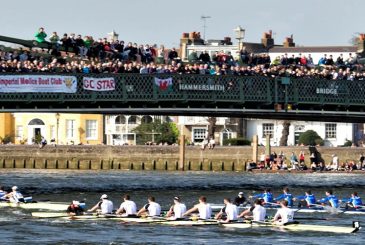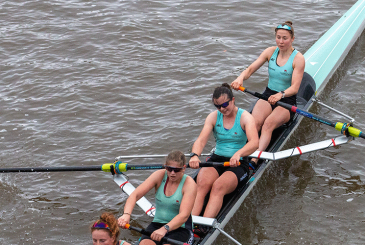Alex McMullen from Junior Rowing News finds out what it takes to secure a place in the side-by-side racing at Henley Women’s Regatta and Henley Royal Regatta via your one and only opportunity to get it right amidst the congestion of the famed time trial format
High stakes
Is it an overstatement to claim that the time trials that precede the two globally renowned Henley Regattas are the most high-pressure head races in world rowing? For those who have trained all year for a shot at racing down the course in front of hundreds, perhaps thousands, of baying spectators, it probably feels like a fair evaluation.
For Henley Women’s Regatta (HWR), every competitor takes to the water during this three-day festival of women’s rowing to test their mettle in a time trial. Some exit the competition at that stage whilst others are purely racing for seeding in the draw. In contrast, at Henley Royal Regatta (HRR), the qualifiers happen the Friday before the regatta proper and only feature some of the crews from the over-subscribed events. The groundswell in interest for both events over the past decade has seen the qualifiers become their own rather compelling spectacle.
Time trial tactics
Tom Copeland, who leads the Cantabrigian RC’s Senior Women’s Squad, has had to help his crews navigate numerous HWR time trials. “If you’re one of the faster crews, then it definitely helps your chances of getting through rounds/making it to Sunday if you give the time-trial and your opposition the respect they deserve,” he said. “If you’re one of the slowest crews, then you also probably need to go all-out to give yourself the best chance of getting hold of one of the last few tickets through to the main part of the regatta”.
“The qualifiers are in and of themselves a legitimate bookmark in people’s racing calendars”
Sir Steve Redgrave, Henley Royal Regatta Chairman
Copland’s belief is that for the crews in the middle of the pack, the psychology is most interesting. “You might decide to hold back a little in the time trial so that you have a little more in the legs later but, of course, you risk there not being a ‘later’ at all.”
For HRR crews, with three full days before you hope to race again, you can be a lot less conservative in your approach than at the HWR qualifiers. But it’s still important to recognise that 2,112m is a long way to try and sprint!
All about preparation
There probably aren’t many people more qualified to discuss the HRR qualifiers than Chairman of the regatta and five-times Olympic gold medallist Sir Steve Redgrave. Speaking to us, he emphasised the importance of arriving early and getting comfortable with new surroundings. “The regatta has become so popular that the qualifiers are in and of themselves a legitimate bookmark in people’s racing calendars,” he said. “As a new crew entering the racing, try to arrive a few hours early and be mindful of Friday traffic coming into Henley.”
Asa Lofstedt, who has coxed three crews to successful qualification at the HRR time trial, recommends going a step further in your preparation efforts. “During my second Henley campaign, we arrived the morning of qualifiers, with plenty of crews on the course causing disruption and making boating difficult,” she explained. “Due to the timings, we only got one practice run up the course. So if you can, try to row on the stretch a day or so beforehand to acclimatise. The booms can be quite daunting if you aren’t used to them. So practice being comfortable with them and in the event of an overtake, having the confidence to squeeze through.”

At HRR, crews who have not already demonstrated that they are clearly of the standard for their event are required to qualify. “It’s important to treat the qualifying event like an ergo,” said Sir Steve. “Don’t be tempted to layer your race plan with loads of bursts that will sap your energy for the second half of the course. Keep the split consistent and if you feel good approaching the enclosures, raise the rate and push for the line.”
Along the straight and narrow
Sir Steve also emphasised the importance of hugging the Berkshire (strokeside) bank. “We do actually put it in our notes, but it’s recommended that you stay towards the right-hand-side of the course as you’re looking up from the finish line,” he said. “If you’re a slower crew being overtaken, it’s also your responsibility to shift out of the way for the faster boat.”
Tom also highlighted steering as a critical factor in a crew’s success. “Before you boat, make sure that you know the full navigation including cross-over points, spinning zones etc and how these change at different times of day throughout the regatta,” he said. “You should also look at how to manoeuvre around the stake boats to get onto the start of the course. When it comes to steering the course itself, the main challenges are managing the wind, the stream, and keeping an eye out for cruisers that can produce wash”.

Meanwhile, Asa stressed the importance of understanding the nature of the river. “Whilst it’s a straight course, it is against the stream so it’s important you’re in the correct position along certain parts of the river,” she said. “Towards the end of the race, there is a conveyor belt effect nearest the grandstand. Don’t miss this!”
Savour the occasion
Beyond all else, enjoy your run down the track. Henley regattas are unlike any other event in the world; blitzing on the blue water in picture-book Oxfordshire countryside whilst thousands cheer you on from their deckchairs. Soak it all up. As Asa says, “there really is no better feeling than hearing your crew called out over the tannoy in the boating tents after that heart-thumping opening, ‘Here is an announcement. The following crews have qualified…’”
Photos: Ed Evans and Jason Clark.










